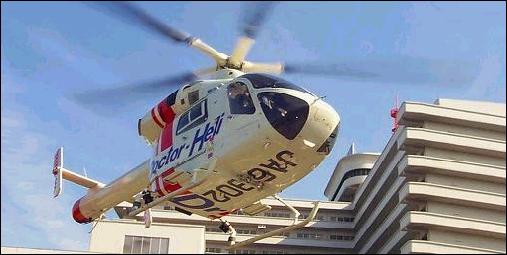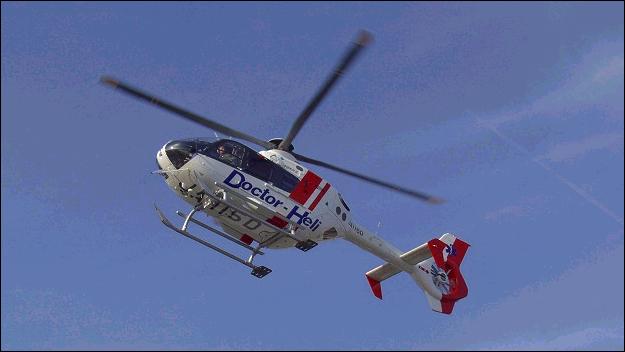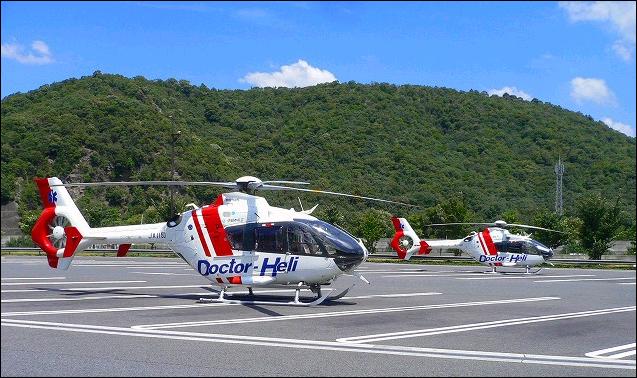<Straight Up>
Birth of the
Doctor Helicopter Special Law

Japan enacted a new law in mid-June that will help increase the use of helicopters for emergency medical service. Formally titled "A law for special measures to secure emergency medical service with helicopters," it is commonly called the "Doctor-Helicopter Special Law."
It is strange that Japan, which thinks of itself as a medically advanced nation, did not have such a law until just weeks ago. But thanks to years of effort by many people concerned with this issue, we finally have a new mandated to hopefully help increase the number of emergency medical helicopter bases in the country. The objective of this new law is to base one emergency medical helicopter in each of Japan's 47 prefectures, which would provide a level of service similar to that of the U.S. and Europe.
Firefighting and police helicopters were introduced several decades ago in Japan: it was in 1958 that the Tokyo Metropolitan Police Department started helicopter operations with a Bell 47, and in 1967 the Fire Department began operations with an Aerospatiale Alouette III single-turbine helicopter. Since then, police and firefighting helicopter fleets have grown on an annual basis, but neither department has operated its helicopters for emergency medical service. This is partly because no one was thinking about integrating emergency medical services with police or firefighting operations.
Because of this lack of integration, the number of injured persons rescued by helicopters in the three days after the January 1995 Great Kobe Earthquake were only 17, compared to the 6,400 who died. This was an unbelievably bungled rescue operation, for at the time, there were more than 1,000 registered helicopters in the civil sector and more than 800 available to the Japan Defense Forces.
In reflection of the poor rescue performance after the Kobe Earthquake, the government set up a "Doctor-Helicopter Study Committee" in 1999 and initiated a working group on developing a program framework for implementing a practical helicopter emergency medical service system. On April 1, 2001 full-fledged helicopter emergency medical service was available after an 18-month trial period that began in late 1999. The program is called "Doctor-Helicopter" in Japan.
Under the program framework, prefectural governments charter medical-equipped helicopters from commercial operators. These helicopters are then kept on standby at bases adjacent to hospitals, and have the ability to takeoff for emergency pick-ups in less than five minutes after receiving a call. The program calls for one doctor and one nurse on each flight, and flight services are available from sunrise to sunset, with no night flying done at this time.
Japan's helicopter emergency medical system is similar to that of Germany's, but Japan's service costs are split evenly between the central and local governments. In Germany and the U.S., however, healthcare insurance pays for these expenses. Each Doctor-Helicopter in Japan cost USD1.5 million per annum, regardless of flight hours or number of missions. Of this cost, 15 percent is paid to the hospital attached to the service to help cover helipad and related administrations cost. The remainder goes to the helicopter operator.
Based on the recognition that helicopter operations funds available from the government are too low to allow commercial operators to maintain a healthy financial state, a bylaw is attached to the new law that requires a three-year study on incorporating health-insurance funding into the system.
Only 11 Doctor-Helicopters operate at present. Using Germany as a guide, Japan needs at least 64 more Doctor-Helicopters to properly cover the country of 378,000 square kilometers, while Germany's 357,000 square kilometers are served by 70 helicopters.
It is good to see that through the Doctor-Helicopter Special Law, the Japanese helicopter emergency medical service system has finally made another step toward an increased level of service.
printed in Japan Aviation Weekly of August 6, 2007)

上の英文は、日本航空新聞社の週刊英字紙に掲載されたものである。。山野豊氏に翻訳していただいた。もともと外国向けの記事なので、日本ではよく知られた内容だが、念のために要旨は下の通りである。
ドクターヘリ特別法の誕生
日本に新しい法律が誕生した。6月なかばのことである。法律の名前は「救急医療用ヘリコプターを用いた救急医療の確保に関する特別措置法」、略して「ドクターヘリ特別措置法」と呼ぶ。医療の先進国をもって自認する日本に、今までこんな法律がなかったのが不思議なくらいだが、関係者の長い間の念願かなってようやく実現することになった。
法律の目的は、救急医療の効果を高めるために救急専用のヘリコプターを全国に普及させること。というのは現在、日本のヘリコプター救急の拠点はわずか11ヵ所しかないためで、これを欧米の先進諸国なみに増やすには、全国47都道府県が地域医療計画の中にヘリコプターの使用を明確に位置づけ、そのための予算措置を講じて、システムづくりをしてゆく必要があると定めたものである。
日本では昔から消防や警察がヘリコプターを使ってきた。東京警視庁がベル47を導入したのは1959年であり、消防庁は1967年アルウェットⅢ単発タービン機を買い入れた。以来、警察および消防のヘリコプターは少しずつ増えていったが、救急業務に使われることはほとんどなかった。救急システムの中にヘリコプターを組み入れるという考え方がなかったからである。
そのため1995年の阪神大震災では6,400人もの犠牲者を出しながら、ヘリコプターで救護された人は3日間でわずか17人という不手際となった。当時日本では、民間ヘリコプターだけで1,000機を超え、自衛隊機を合わせると約2,000機が飛んでいたのである。
この反省の上に立って、政府は1999年「ドクターヘリ調査検討委員会」を設置、ヘリコプター救急のシステムづくりに着手した。そして99年から1年半の試行期間を経て、2001年4月1日から本格的な事業を開始となった。
このヘリコプター救急事業は、日本では「ドクターヘリ」と呼ばれる。各都道府県がヘリコプター運航会社から救急装備をつけた専用機をチャーターし、救命救急センターの敷地内に待機させ、消防機関からの要請に応じて2~5分で離陸する。乗るのは医師と看護師。待機の時間は日中のみで、夜間飛行はしない。
こうした体制はドイツのヘリコプター救急体制に似ているが、大きく異なるのは費用負担の方法である。ヘリコプターの運航費を、ドイツやアメリカは健康保険や医療保健から支払われるのに対し、日本のドクターヘリは国が半分、地方自治体が半分ずつで、それも飛行時間や出動回数にかかわりなく年間およそ150万ドルに固定されている。
そのうち15%程度は病院側のヘリコプター関係費――ヘリポート整備費などに取られるので、ヘリコプターの運航費は130万ドルに満たない。これでは低すぎるというので、新しい法律は今後3年以内に費用負担のあり方をどうするか、健康保険の適用を含めて検討するという「付則」をつけ加えている。
こうしたドクターヘリは現在まだ11ヵ所にしか配備されていない。日本の国土面積は378,000平方キロ、ドイツは357,000平方キロだから、日本がドイツの拠点70ヵ所に肩を並べるには75機のヘリコプターを配備しなければならない。その理想に向かって、日本のヘリコプター救急体制は今ようやく最初の1歩を踏み出した。

(西川 渉、2007.8.16)
